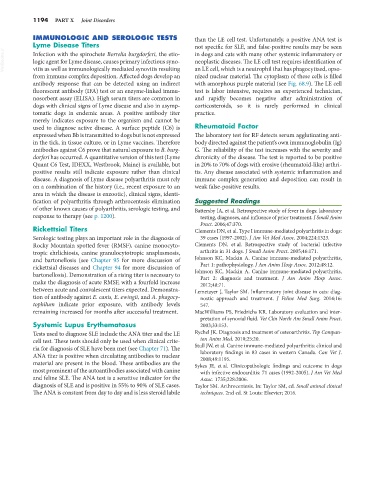Page 1222 - Small Animal Internal Medicine, 6th Edition
P. 1222
1194 PART X Joint Disorders
IMMUNOLOGIC AND SEROLOGIC TESTS than the LE cell test. Unfortunately, a positive ANA test is
Lyme Disease Titers not specific for SLE, and false-positive results may be seen
VetBooks.ir Infection with the spirochete Borrelia burgdorferi, the etio- in dogs and cats with many other systemic inflammatory or
neoplastic diseases. The LE cell test requires identification of
logic agent for Lyme disease, causes primary infectious syno-
vitis as well as immunologically mediated synovitis resulting
nized nuclear material. The cytoplasm of these cells is filled
from immune complex deposition. Affected dogs develop an an LE cell, which is a neutrophil that has phagocytized, opso-
antibody response that can be detected using an indirect with amorphous purple material (see Fig. 68.9). The LE cell
fluorescent antibody (IFA) test or an enzyme-linked immu- test is labor intensive, requires an experienced technician,
nosorbent assay (ELISA). High serum titers are common in and rapidly becomes negative after administration of
dogs with clinical signs of Lyme disease and also in asymp- corticosteroids, so it is rarely performed in clinical
tomatic dogs in endemic areas. A positive antibody titer practice.
merely indicates exposure to the organism and cannot be
used to diagnose active disease. A surface peptide (C6) is Rheumatoid Factor
expressed when Bb is transmitted to dogs but is not expressed The laboratory test for RF detects serum agglutinating anti-
in the tick, in tissue culture, or in Lyme vaccines. Therefore body directed against the patient’s own immunoglobulin (Ig)
antibodies against C6 prove that natural exposure to B. burg- G. The reliability of the test increases with the severity and
dorferi has occurred. A quantitative version of this test (Lyme chronicity of the disease. The test is reported to be positive
Quant C6 Test, IDEXX, Westbrook, Maine) is available, but in 20% to 70% of dogs with erosive (rheumatoid-like) arthri-
positive results still indicate exposure rather than clinical tis. Any disease associated with systemic inflammation and
disease. A diagnosis of Lyme disease polyarthritis must rely immune complex generation and deposition can result in
on a combination of the history (i.e., recent exposure to an weak false-positive results.
area in which the disease is enzootic), clinical signs, identi-
fication of polyarthritis through arthrocentesis elimination Suggested Readings
of other known causes of polyarthritis, serologic testing, and Battersby IA, et al. Retrospective study of fever in dogs: laboratory
response to therapy (see p. 1200). testing, diagnoses, and influence of prior treatment. J Small Anim
Pract. 2006;47:370.
Rickettsial Titers Clements DN, et al. Type I immune-mediated polyarthritis in dogs:
Serologic testing plays an important role in the diagnosis of 39 cases (1997-2002). J Am Vet Med Assoc. 2004;224:1323.
Rocky Mountain spotted fever (RMSF), canine monocyto- Clements DN, et al. Retrospective study of bacterial infective
tropic ehrlichiosis, canine granulocytotropic anaplasmosis, arthritis in 31 dogs. J Small Anim Pract. 2005;46:171.
and bartonellosis (see Chapter 95 for more discussion of Johnson KC, Mackin A. Canine immune-mediated polyarthritis,
Part 1: pathophysiology. J Am Anim Hosp Assoc. 2012;48:12.
rickettsial diseases and Chapter 94 for more discussion of Johnson KC, Mackin A. Canine immune-mediated polyarthritis,
bartonellosis). Demonstration of a rising titer is necessary to Part 2: diagnosis and treatment. J Am Anim Hosp Assoc.
make the diagnosis of acute RMSF, with a fourfold increase 2012;48:71.
between acute and convalescent titers expected. Demonstra- Lemetayer J, Taylor SM. Inflammatory joint disease in cats: diag-
tion of antibody against E. canis, E. ewingii, and A. phagocy- nostic approach and treatment. J Feline Med Surg. 2014;16:
tophilum indicate prior exposure, with antibody levels 547.
remaining increased for months after successful treatment. MacWilliams PS, Friedrichs KR. Laboratory evaluation and inter-
pretation of synovial fluid. Vet Clin North Am Small Anim Pract.
Systemic Lupus Erythematosus 2003;33:153.
Tests used to diagnose SLE include the ANA titer and the LE Rychel JK. Diagnosis and treatment of osteoarthritis. Top Compan-
cell test. These tests should only be used when clinical crite- ion Anim Med. 2010;25:20.
ria for diagnosis of SLE have been met (see Chapter 71). The Stull JW, et al. Canine immune-mediated polyarthritis: clinical and
laboratory findings in 83 cases in western Canada. Can Vet J.
ANA titer is positive when circulating antibodies to nuclear 2008;49:1195.
material are present in the blood. These antibodies are the Sykes JE, et al. Clinicopathologic findings and outcome in dogs
most prominent of the autoantibodies associated with canine with infective endocarditis: 71 cases (1992-2005). J Am Vet Med
and feline SLE. The ANA test is a sensitive indicator for the Assoc. 1735;228:2006.
diagnosis of SLE and is positive in 55% to 90% of SLE cases. Taylor SM. Arthrocentesis. In: Taylor SM, ed. Small animal clinical
The ANA is constant from day to day and is less steroid labile techniques. 2nd ed. St Louis: Elsevier; 2016.

